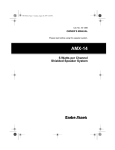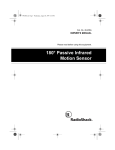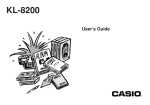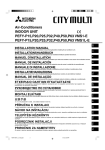Download Radio Shack 49-537 Owner`s manual
Transcript
49-537.fm Page 1 Thursday, August 19, 1999 9:16 AM OWNER’S MANUAL DIGITAL KEY SWITCH Please read before using this equipment. Cat. No. 49-537 49-537.fm Page 2 Thursday, August 19, 1999 9:16 AM INTRODUCTION Your Radio Shack Digital Key Switch is a highquality, UL-approved security keypad that connects to your alarm system and eliminates the need for a key to arm and disarm your alarm. Instead, you simply enter your personally selected four-digit code. The keypad’s microprocessor lets you select from 10,000 possible codes. You can change the code as often as you like. Your keypad has these features. Selectable Arm/Disarm Mode Switch — lets you use the switch to control a wide variety of security systems or other remote-switched devices. ARM and LOOP Indicators —show the alarm’s status (if your system provides connections for remote arm and remote loop indicators). 1994 Tandy Corporation. All Rights Reserved. Radio Shack is a registered trademark used by Tandy Corporation. 2 49-537.fm Page 3 Thursday, August 19, 1999 9:16 AM Panic Circuit —lets you quickly trigger the alarm from the keypad. Built-in Tamper Switch— sounds the alarm if someone tries to remove or damage the switch. Wrong Number Lockout —makes you wait 10 seconds between incorrect attempts to discourage random code number entries by unauthorized persons. This product is UL listed under Standard Number 1023, “Household Burglar-Alarm System Units.” Use only with UL-Listed security devices. 3 49-537.fm Page 4 Thursday, August 19, 1999 9:16 AM CONTENTS Will fix 4 49-537.fm Page 5 Thursday, August 19, 1999 9:16 AM READ THIS FIRST Properly connecting and installing the keypad requires careful planning before you begin. Read this entire manual and plan your installation before continuing. This manual includes specific connection drawings for Radio Shack alarm systems as well as general information for use with other security devices. Check your security device’s owner’s manual for specific instructions. Here are some important points to consider when planning your installation: • Where will you mount the keypad? — the keypad is designed only for indoor installation. It should be readily accessible to those who will use it, but should not be easily seen by an intruder. • How many wires do you need and how long must they be? — determine this information by reading “Connections” and checking your alarm system’s manual. 5 49-537.fm Page 6 Thursday, August 19, 1999 9:16 AM • What other hardware and tools do you need? — you should mount the keypad in a standard single-gang electrical box (the kind used for single wall switches and AC outlets). See “Installation.” Once you install this box, all you need is a screwdriver to complete the keypad’s installation. Note: You can mount the keypad directly on wooden or plasterboard walls, without an electrical box. However, the box gives added security and protection. 6 49-537.fm Page 7 Thursday, August 19, 1999 9:16 AM CONNECTIONS This section gives basic guidelines for connecting the wires from your alarm system to the keypad. If you are using a Radio Shack alarm system, see the separate wiring diagrams for the exact connections. The keypad is compatible with many alarm systems. However, some systems might not use all the keypad’s features. Also, each system requires some variations in wiring connections. After determining the wiring requirements, see “Installation” for actual installation instructions. (illust of keypad’s back panel) 7 49-537.fm Page 8 Thursday, August 19, 1999 9:16 AM REMOTE N.O. (Normally Open) Terminals —these terminals connect to your alarm system’s remote arm/disarm terminals. They provide the switch closure needed to arm and disarm the alarm. Note: Some systems require connection to normally closed remote arm/disarm terminals. If your system has a normally closed switch, you must set LATCH to IN and enter your code twice to arm and disarm the system. TAMPER/PANIC (N.O.) Terminals—these terminals connect to the alarm’s normally open tamper/panic loop. These terminals provide the signal to trigger your alarm if someone tampers with the keypad or you press # and Q on the keypad at the same time. Note: If your system only has a normally closed panic loop, do not use these terminals. 8 49-537.fm Page 9 Thursday, August 19, 1999 9:16 AM ARM LED Terminals (+/–)—these terminals connect to the alarm’s remote arm indicator terminals. Follow the marked polarity (+ and –) to make the connection. When power is applied to these terminals, the red ARM indicator on the front panel turns on. Notes: • Some systems might not have connections for remote arm indicators. These connections are not necessary for operation. • If your system has an LED symbol ( ) above its terminals instead of polarity markings, use this drawing to determine the correct connections. Illustration: Diode Symbol and connections 9 49-537.fm Page 10 Thursday, August 19, 1999 9:16 AM LOOP LED Terminals— these terminals connect to your alarm system’s remote loop indicator terminals. Follow the marked polarity (+ and –). When power is applied to these terminals, the green LOOP indicator turns on. Notes: • Some systems might not have connections for remote loop indicators. These connections are not necessary for operation. • If your system has the schematic symbol for a diode, instead of polarity markings, use the illustration of the diode symbol on Page 9 to determine the correct connections. POWER (DC10-18VDC) Terminals—these terminals connect to a constant source of 10-18 volt DC power provided by your alarm system. Follow the marked polarity (+ and –). These connections provide power to the keypad. 10 49-537.fm Page 11 Thursday, August 19, 1999 9:16 AM HOW AND WHEN TO USE THE JUMPER The keypad has a three-terminal jumper connected to the positive (+) side of the ARM, LOOP, and POWER terminals. If your system uses a common positive power supply for these three connections, you can route a single wire from your alarm panel and connect it to one terminal. The jumper bridges power to the other two terminals. If your system has a common positive connection for the indicators, leave the jumper where it is and make connections similar to the drawing below. Illustration: Connection positive common. 11 49-537.fm Page 12 Thursday, August 19, 1999 9:16 AM If your system has common negative (–) connections for its indicators, move the jumper to the negative ARM, LOOP, and POWER terminals and make connections similar to the drawing below. Illustration: Connection negative common. If your system does not have polarity markings or other means of determining the common terminal, route a separate wire from your alarm system to each terminal. 12 49-537.fm Page 13 Thursday, August 19, 1999 9:16 AM INSTALLATION Installation Hints: • Before installing the keypad, temporarily connect the alarm and the keypad terminals to confirm proper operation. If you have problems, see “Problem Solving.” • Install the switch indoors away from dust, dirt, and temperature or humidity extremes. Refer to the illustration on Page 16 and follow these steps to install the switch. 1. Select a location on the wall next to a wall stud. 2. Use a single-gang electrical box as a template and make a hole the size of the electrical box. 3. Route connection wires from the alarm system to the hole (through attic, walls, and so on) and through a knock-out plug in the electrical box. Leave extra wire for connection to the keypad. 4. Insert the box into the hole and nail it to the wall stud; the box should be recessed slightly below the surface of the wall. 13 49-537.fm Page 14 Thursday, August 19, 1999 9:16 AM 5. Connect the wires to the keypad terminals. If connecting to a Radio Shack system, refer to the supplied wiring diagrams. Otherwise, refer to “Connections.” To make a connection: a. Loosen the keypad’s screw terminal. b. Strip 1/2 inch of insulation from the wire end. c. Wrap the bare wire around the screw terminal. Be sure no stray wire strands touch any other terminal. d. Tighten the screw. 6. Set LATCH IN/OUT to the correct position for your system. • When set to IN , the keypad shorts the remote terminals when you enter the code, and keeps them shorted until you enter the code again. Use this setting if the original arm/disarm switch is a two-position switch (one position for armed, the other position for disarmed) or a normally-closed switch. 14 49-537.fm Page 15 Thursday, August 19, 1999 9:16 AM • When set to OUT, the keypad shorts the remote terminals for 21/2 seconds when you enter the code. Use this setting if the original arm/disarm switch is a spring-loaded type, normally-open switch that has a momentary contact. If you are not sure what setting to use with your system, check your system’s owner’s manual or contact the manufacturer. Notes: • Set LATCH IN/OUT before you connect power to the switch. If you set it after power is applied, the keypad might not recognize the changed setting. • If your system uses a normally-open switch and you have to enter your security code twice to arm/disarm the system, set LATCH to OUT. 7. Remove the screw from the bottom of the keypad. Then remove the keypad’s front cover. 15 49-537.fm Page 16 Thursday, August 19, 1999 9:16 AM 8. Secure the keypad to the box using two screws. Then replace the keypad’s front cover and secure it with the screw you removed in Step 7. 9. Connect the other end of the wires to the appropriate terminals on your alarm system. 10. Carefully push the wires into the box and attach the keyboard portion of the keypad to the box using the supplied set screw. Illustration: Installing the Key Switch. 16 49-537.fm Page 17 Thursday, August 19, 1999 9:16 AM OPERATION AND TESTING SETTING THE SECURITY CODE When you first connect power to the keypad, and any time after the keypad loses power, it uses the preset factory security code (1 2 3 4). Follow these steps to set your own security code. Note: If you take longer than 10 seconds to complete Step 2, 3, or 4, the keypad automatically resets to the old code. Begin again from Step 1. 1. Press Q. 2. Enter the current security code. 3. Press Q again. 4. Enter your desired four-digit personal code. Notes: • We suggest that you avoid obvious numbers such as your street address, birth date, and so on. Also, it is a good idea to periodically change your code. 17 49-537.fm Page 18 Thursday, August 19, 1999 9:16 AM • If you make an error when entering your new code, press # to clear the incorrect entry and repeat this step. 5. Press Q to store the new code. Note: If you forget the code number, temporarily disconnect power from the keypad. This resets the code to the factory default code (1 2 3 4). 18 49-537.fm Page 19 Thursday, August 19, 1999 9:16 AM ARMING/DISARMING THE ALARM To arm the system, enter your code. If you connected the keypad to your system’s remote arm indicator terminals, the ARM indicator should light. Note: If the ARM indicator lights when the system is disarmed, you have probably connected the keypad to the wrong remote arm terminals on the alarm system. Check all connections and try again. To test the system, arm the system, then set off the alarm to confirm its operation. To disarm the system, enter your code. If you enter an incorrect code, you must wait 10 seconds to try again. Notes: • The keypad does not accept any key input for 21/2 seconds after you enter your code. 19 49-537.fm Page 20 Thursday, August 19, 1999 9:16 AM • If the keypad does not respond to your code, there might have been a power failure while you were away or there might be a loose, intermittent connection at the POWER terminals. In either case, the keypad resets to the factory code (1 2 3 4) when power is restored. ARM AND LOOP INDICATORS The operation of these indicators varies depending on the type of alarm system you use. Some systems use both indicators, while others might use only one or neither. In most cases, these indicators should respond the same way as corresponding indicators on the main alarm panel. If you connect these indicators but they do not work, check for loose connections or incorrect polarity. 20 49-537.fm Page 21 Thursday, August 19, 1999 9:16 AM PANIC CIRCUIT If you connected the keypad’s PANIC terminals to a 24-hour panic/tamper loop on your alarm system, pressing # and Q at the same time trips the alarm, whether or not the system is armed. On some alarm systems, you can silence the panic alarm by entering your code at the keypad. If this does not work, reset it at the main alarm system. TESTING THE SYSTEM Important: To prevent false alarms when testing your system, be sure to disconnect security dialers or any other devices that send a message to a remote location. Your alarm system sounds during these tests. Be sure to notify your neighbors and any proper authorities of the test. Check the system once a week to be sure it is operating properly. Refer to the main control unit’s operation instructions for proper test procedures. 21 49-537.fm Page 22 Thursday, August 19, 1999 9:16 AM PROBLEM SOLVING If you have problems, these suggestions might help. Keypad does not arm or disarm your system. • Be sure all connections are correct. • Check for the proper setting of LATCH IN/OUT. • The security code resets to the preset factory code (1 2 3 4) if power has been disconnected. You cannot remember your code. • Temporarily disconnect power to reset to the factory code (1 2 3 4). Note: If your system has battery back-up, you must also disconnect the battery. You cannot silence the alarm from the keypad after activating the panic circuit. • 22 Your alarm system is not equipped for this feature. Reset the alarm from the alarm system. 49-537.fm Page 23 Thursday, August 19, 1999 9:16 AM SPECIFICATIONS ELECTRICAL Power Requirements . . . . . . . . . . . 10 to 18V DC Power Consumption . . . . . . . . . 10 mA @ 16VDC (LEDs off) (Plus 12 mA @ 16VDC when one LED is on) GENERAL Automatic Reset . . . . . . . . . . . . 10 Seconds after 1st Key Press Remote Relay Contact Time . . . . . . . 2.5 Seconds (Nominal) Panic Relay Contact Time . . . . . . . . 2.5 Seconds (Nominal) Relay Contact Capacity . . . . . . . . . 24VDC @ 1A (Resistive Load) Dimensions (HWD) . . . . . . 45/16 × 3 × 11/4 Inches (110 × 74 × 31 mm) Factory preset code . . . . . . . . . . . . . . . . . 1 2 3 4 Specifications are typical; individual units might vary. Specifications are subject to change and improvement without notice. 23 49-537.fm Page 24 Thursday, August 19, 1999 9:16 AM RADIO SHACK LIMITED WARRANTY This security product is warranted against manufacturing defects in material and workmanship for ninety (90) days from the date of purchase from Radio Shack company owned stores and authorized Radio Shack franchisees and dealers. Within this period Radio Shack will repair the security product without charge for parts and labor. Simply bring your Radio Shack sales slip as proof-of-purchase date to any Radio Shack store. This warranty does not cover damage or failure caused by or attributable to Acts of God, abuse, misuse, improper or abnormal usage, faulty installation, improper maintenance, lightning or other incidence of excess voltage, or any repairs other than those provided by a Radio Shack Authorized Service Facility, or transportation costs. Radio Shack is not responsible or liable for indirect, special, or consequential damages arising out of or in connection with the use or performance of the product or other damages with respect to loss of property, loss of revenues or profit, or costs of removal, installation or reinstallation. EXCEPT AS PROVIDED HEREIN, RADIO SHACK MAKES NO WARRANTIES, EXPRESS OR IMPLIED, INCLUDING WARRANTIES OF MERCHANTABILITY AND FITNESS FOR A PARTICULAR PURPOSE. Some states do not allow the limitation or exclusion of incidental or consequential damages and some states do not allow limitation or exclusion of implied warranties; therefore, the aforesaid limitation(s) or exclusion(s) may not apply to the purchaser. There will be charges rendered for repairs to the product made after the expiration of the aforesaid ninety (90) day warranty period. This warranty gives you specific legal rights and you may have other rights which vary from state to state. We Service What We Sell RADIO SHACK A Division of Tandy Corporation Fort Worth, Texas 76102 10A4 811089380A Printed in Hong Kong

































